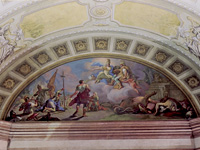The frescos in the “war wing”
|
Contrapuntally to the themes of the “peace wing” are the depictions in the “war wing”, which are the first things noticed when you enter the Hall. The lunette picture over the columns shows the mythological story of Cadmus, who sowed the teeth of a slain dragon. From that sowing spring forth warriors. According to mythology Cadmus gave the Greeks the alphabet. Through his mastery of the practical arts, of which the art of war is one, he saves the harmony and the order of the world. That theme is found again in the ceiling picture in this section, which is dedicated to “study of earthly things”. In the middle there is a depiction of Vigilance, surrounded by Care of Health and Tilling of the Soil. Pictured on the lower edge are Mechanics and Defence. The fresco on the side of the “circular arch” turned toward the cupola shows “Vulcan’s forge”. “Scientific striving”, alarmed by the din of weapons, is accompanied in time of war by the geniuses of “Valour”. In the Baroque iconography of the ruling family the allegorical presentation of war and peace, of earthly and heavenly spheres, strength and wisdom, are not opposites that neutralise each other, but complementary aspects of an ordered world that find their centre in the person of the ruler. The task of science is solely to bear witness to that for future generations. Daniel Grans’s depiction of the sciences in the cupola oval of the State Hall is the artistic expression of that Baroque program of the ruling class. |


